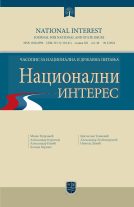- Home page
- Researchers
- Branislav Milosavljević
Branislav Milosavljević
Institut za strategijska istraživanja, Univerzitet odbrane

CONSTRUCTION STRATEGY NATIONAL IDENTITY OF MONTENEGRO
As one of the youngest countries in Europe, Montenegro is a particularly interesting example of how a symbolic competition between two nation-building projects takes place in the political context. The issue of Montenegrin national identity has been at the heart of Montenegrin politics since the late 19th century, but there has never been a clear consensus on who exactly Montenegrins are. Supported by the reconstructed meaning of the Montenegrin nation, the newly formed Montenegrin national consciousness accelerated after the break with Serbia and the declaration of independence on May 21, 2006. Since the break-up of Yugoslavia, Montenegro has gone through transitions from a republic in the Federal Republic of Yugoslavia (FRY) to a member state of Serbia and Montenegro in the period 2003-2006. year, and after that to an independent state from 2006 year. However, the transition of statehood was not the result of a broader popular consensus. The split in the ruling political party of reformed communists, the Democratic Party of Socialists (DPS) in 1997, sparked a political struggle between the party's two former factions. Over a period of 15 years, the changing political programs of the ruling DPS and the opposing Socialist People's Party (SNP) served as a source for redefining the meaning of ethnic (national) identity. In their competition for social, political or economic resources, Montenegrin elites, by applying political and ethno-cultural state policy and active use of the media, have managed to turn certain facts and events into reference points for the citizens of Montenegro by identifying themselves. Therefore, these events became the basis of belonging to a community and at the same time helped to separate the specific community of Montenegro from Srpska.
